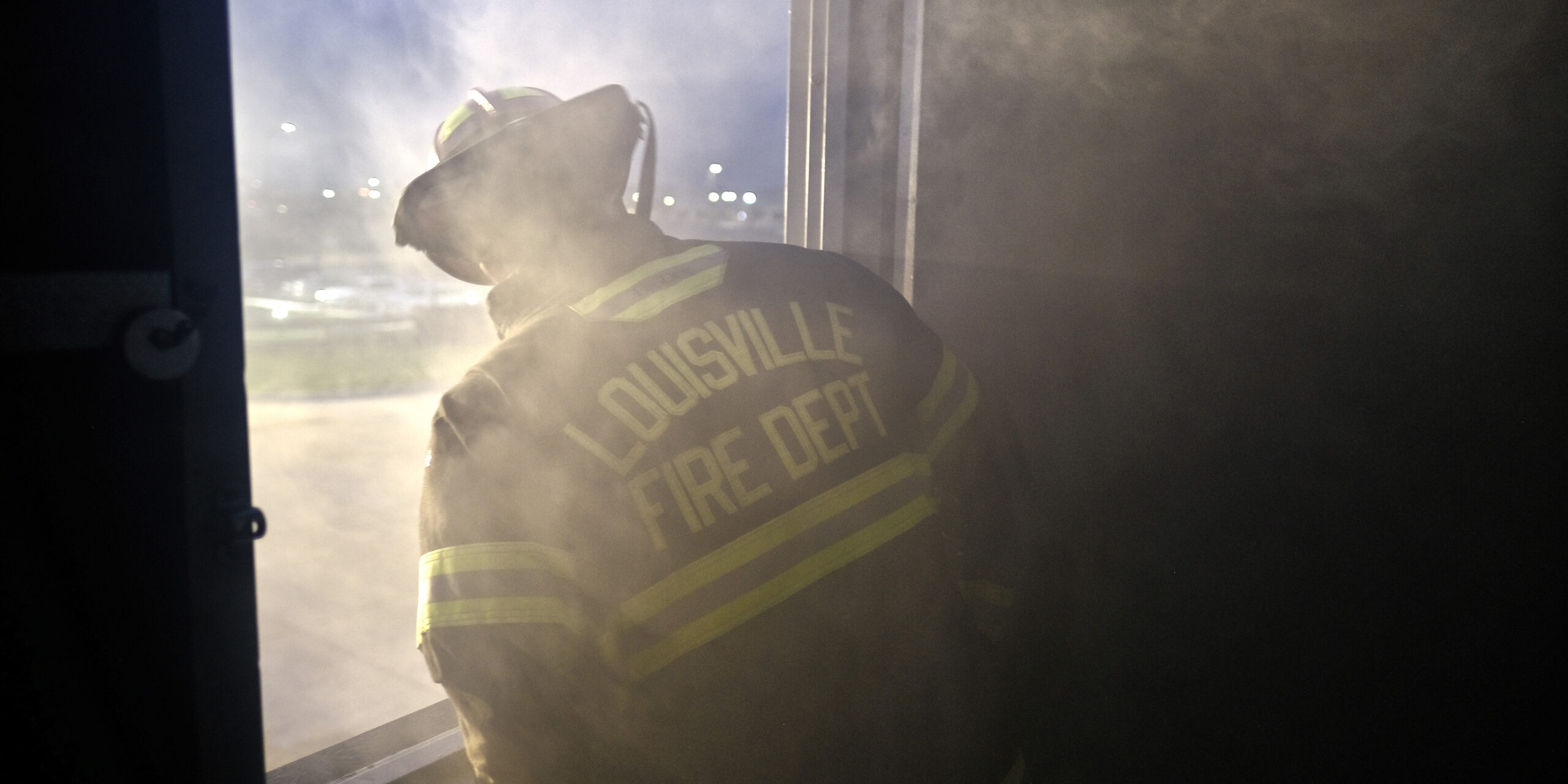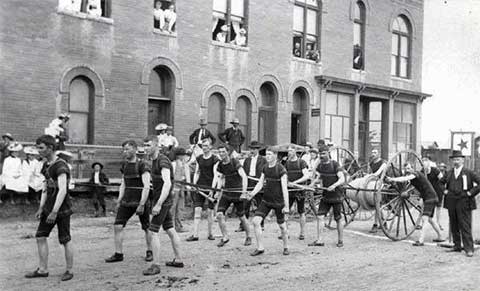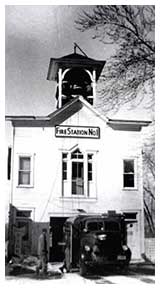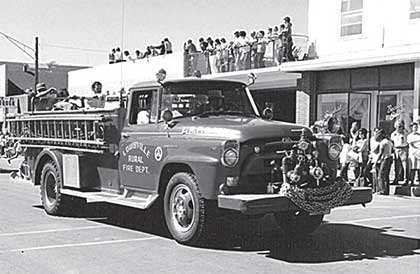History

Firefighters Prayer
When I am called to duty,
God wherever flames may rage,
give me strength to save a life,
whatever be its age.
Help me to embrace a little child before it’s too late,
or save an older person from the horror of that fate.
Enable me to be alert to hear the weakest shout,
and quickly and efficiently to put the fire out.
I want to fill my calling and to give the best in me,
to guard my neighbor and protect his property.
And if according to your will I have to lose my life,
bless with your protecting hand my loving family from strife.
Serving Louisville Since 1885
In 1885, the first known fire companies were established in Louisville to support the various local coal mines. The Welch Mine and Welch hose company provided fire suppression to the town until around 1895 when a group of local citizens started to petition the local trustees asking for a volunteer fire company dedicated to protecting the local homes. In February of that year, the trustees approved a local ordinance to create a city department and incorporation papers were filed with the state of Colorado. The 1895 ordinance also specified that there would be a chief engineer, an assistant chief engineer, and a hook and ladder company with no more than 50 members, and a hose company with no more than 30 active members. The first ordinance went on to outline the rules and authority at a fire, “In all cases of fire the hose company that shall reach a fire hydrant first with the necessary hose, shall be entitled to use the hydrant. If the company does not have enough hose the other company can attach their hose, however, the first company was entitled to use the nozzle at the fire”.

Hose Carts
Like most hose companies of that era, Louisville experienced its fair share of devastating structure fires. Fire was used as a primary source of heating and cooking, making fires a common experience. Unfortunately, water for fighting fire was scarce and there was no municipal water system like we enjoy today. Until the city established its own water system, fire companies used bucket brigades from the various cisterns, ponds, creeks and elevated water tanks. Around 1898, the community received its first hose cart, and would eventually have 3 dedicated hose carts before the first hose truck was put in service in 1932.
1st Fire Station
In January of 1900, a bell tower was constructed to alert the local volunteer hose companies and in 1902 a new town hall and fire station was built for $1,500. In 1952 the community built a new city hall with the fire department still attached. After 100 years of providing fire service to the city of Louisville, the various local coal mines and some surrounding area farms, the department built a stand-alone fire station on North Main Street where it is still in service today.


1st New Fire Truck
The City approved the purchase of its first new fire truck, a 1952 International for $9,000.
1977 – From Department To District
As time passed and the community grew, the department transitioned from a city department to a special district. In 1977, the board of directors soon realized that a second station was necessary to meet the service demands of a growing community. Station #2 was built in 1985 and currently serves as the district headquarters and administrative building.
Past Fire Chiefs
Ben Woods 1912-1917
Ben Niehoff 1918-1928
L.J. Mossoni 1929
Mike Fabrizio 1930
Ben Newrock 1931
Harry Jenkins 1932-1935
Eugene Madonna 1936
Art O’ Hanian 1937
Charles Bottenelli 1938
Mike Fabrizio 1939
John Lombardi 1940
John Ross 1941
Anthony Jacovetta 1942
Pete Franchini 1943
Jim Fenolia 1944
John Stevens 1945
Ricco Ferrari 1946
Harold Cornelius 1947
Dom Tomeo 1948
Bill Dhieux Sr. 1949
Joe Campana 1950
L.C. Graves 1951
Andy Deborski 1952
Nick Patete 1953
Darwin Johnson 1954
Arnold Banyai 1955
Tom Cable 1956
Herb Steinbaugh 1957
Lawrence Caranci 1958
Frank Malczyk 1959
Gene Barday 1960
Leo DeBorski Jr. 1961
F.W. Barday 1962
Joe Santi 1963
George Lazuk 1964
Ron Leggett 1965
Les Davis 1966
George Brown 1967
Dean Weber 1968
Art Symanski 1969
Don Spurr 1970
Bill Ryan 1971-1973
Ken Buffo 1974
Duane Elrod 1975
Tom Poydock 1976-1977
Howard Pollock 1978-1979
Wayne Varra 1980
Dale Fry 1981
John Littlejohn 1982
Larry Hudson 1983
Dan Ross 1984-1986
Chuck Schmidt 1987-1988
Phil Paolilli 1989
Vince Ferrara 1990-1991
Mike Rangel 1992-1996
David Yost 1997
Bill Dhieux Jr. 1998
Cris Brewer 1999-2001
Chris Mestas 2002
Michael Schick 2003-2004
Tim Parker 2005 – 2015
LFPD Deceased Fire Fighters
Affolter, John
Allera, John
Anderson, Randall
Austin, Roy
Bammer, Lemoine
Banyai, Arnold
Barday, Gene
Baumer, John
Berardi, Frank
Beveridge, Tom
Biella, Herman
Biella, Sandy
Black, Martin
Blakely, John
Bollinger, John
Bottinelli, Charles
Brown, Abe
Buffo, Don
Cable, Tom
Campana, Joe
Camps, Greg
Caranci, Eugene
Caranci, Lawrence
Cliff, Tom
Colacci, Joe
Cornelius, Harold
Damelia, Joe
Davis, Les
Decker, Daryl N.
Deborski, Andrew
Deborski, Leo Sr.
DelPizzo, Albert
DeSantis, Rocco
Dhieux, Bill
DiCarlo, Eugene
DiFrancia, Nick
DiGiacomo, Jack
Dionigi, Rudy
Domenico, Frank S.
Domenico, Guy
Domenico, Jim
D’Amato, Joe
Ellis, George
Elrod, Duane
Fabrizio, Mike
Fenolia, Jim
Fenolia, Tony
Ferguson, David
Ferguson, Robert
Ferrera, Michael P
Ferrari, Angelo
Ferrari, Fred
Ferrari, James
Ferrari, Ricco
Fisher, Frank
Fletcher, Harley Jr.
Franchini, Baptist
Franchini, Richard
Franchini, Pete
Garcia, Henry
Giorzelli, Joe
Giorzelli, John
Golden, George
Graves, L.C.
Grosso, Charles
Gurule, Melvin Jr
Guenzi, Louis
Guenzi, Milo
Gutfelder, Tony
Hamilton, Frank
Harney, Joe
Harney, John
Harris, James
Havens, Dale
Hawkins, Henry
Henander, Jack
Henning, G.R.
Hicks, John
Hicks, Monroe
Hilton, Bill
Horn, Tom
Jacoe, Eliseo
Jacoe, Enricho
Jacoe, Frank
Jacoe, Robert
Jacovette, Anthony
Janezic, Joe
Jenkins, Harry
Johnson, Darwin
Koprowski, Allan
Kroell, John
Lacey, Richard A.
Lahr, Steve
Largo Dom
LaSalle, John
LaSalle, William
Lasnik, Adolf
Lawrence, Fred
Lazuk, George
Leggett, Ron
Lewand, Joe
Liddle, Tom
Littlejohn, Claude
Lombardi, John
Machin, Harold
Madonna, Eugene
Madonna, Quino
Malczyk, Frank
Malfitano, Emil
Malone, Frank
McDonald, Allen
McNally, Harry
Milano, Richard
Moffitt, John
Morgan, George
Morgan, John
Mossoni, L.J.
Mudrock, George
Negri, Aldo
Neihoff, Ben
Newrock, Ben
O’Hanion, Art
Palmer, Richard
Parks, Awra
Patete, Dominic
Petren, Mike
Porta, John G.
Porta, John L.
Poss, David B.
Rickman, Ronald
Rizzi, Tom
Robbins, Jody
Robinson, Ben
Rockley, Newton
Rohrbach, Larry
Romano, Celeste
Romano, Tony
Ross, John
Rotar, Martin
Rotar, Tom
Ryan, William
Santi, Joseph F.
Scarpella, Chuck
Schaffer, Dan
Schmidt, Chuck
Shaw, Brian
Shook, Larry
Sirockman, George Jr.
Sirockman, George Sr.
Slavec, Rudy
Steinbaugh, Glenn
Steinbaugh, Herbert
Steinbaugh, John A.
Stevens, Joe Sr.
Stevens, John
Stevens, Tom
Stretz, Robert
Stubbs, Duncan
Tharp, E R (Bud)
Thirlaway, John
Thirlaway, Owen
Thirlaway, Robert Jr.
Thirlaway, Robert Sr.
Thirlaway, Vic
Thirlaway, William
Thompson, George
Todd, Otto
Tomeo, Dom
Venette, Todd
Willis Robert
Winkler, Herman
Woods, Ben
Zarina, Charles
Zarina, Joe
Zarina, Peter
Zurich, Joe
9/11 Tribute
What started as an ordinary fall day quickly turned into a devastating terrorist attack on our country that changed the trajectory of many lives.
We will never forget the first responders who paid the ultimate sacrifice to save as many lives as possible. There are so many stories of heroism and courage exhibited on that day; here are three stories demonstrating the values of the fire service and acts of heroism:
Chief Ray Downey was in charge of rescue operations at the tower site on 9/11. Being in charge, he could have set up his operation at a safe distance from the incident, but that was not the makeup of this 39-year veteran of the FDNY. As a former U.S. Marine and one of the most decorated officers in the department’s history, he chose to run rescue operations on the front line and actively participate in rescues in the south tower. Chief Downey did what he had always done — he placed the well-being of others before his own. While the south tower’s collapse took his life, it did not take the spirit of the firefighters he led.
Another example was Chief of Department Peter Ganci, the highest-ranking officer of the FDNY; he survived the first building collapse of the south tower. Many of his command personnel could climb out of the basement where the initial command post was placed. Chief Ganci then sent everyone north to set up a new command post out of harm’s way. Instead of going directly to the command post, he started rescue operations on West Street, leaving him in the collapse zone when the north tower fell. Despite the personal risk, he felt that he could do the most good for his firefighters and civilians by setting up a new rescue operations area before going to the command post. There is no doubt that his actions saved many lives.
Lastly, we recall the story about the courageous FDNY Chaplain Mychal Judge. While sworn firefighters did not fill this position, it was common practice for FDNY chaplains to respond to any significant incident in New York City. Without concern for his safety, Chaplain Judge responded, as he had so many times before, to administer Last Rites to firefighters and civilians. Shortly after his arrival, he was hit by falling debris, which killed him instantly. He was one of the first casualties on the ground from the attack.
“Never forget” is a phrase that the American fire service and the Louisville Fire Protection District use to remember the 343 brave firefighters that lost their lives in the line of duty on 9/11. In that spirit, we dedicated a bronze plaque at Station 1, marking the significance of that day in American history. It also serves as a daily reminder of the risks associated with our jobs and that we should never take for granted what we have learned from those who sacrificed the most. We encourage everyone to visit our 9/11 memorial plaque and our recently dedicated World Trade Center metal piece at Fire Station One.